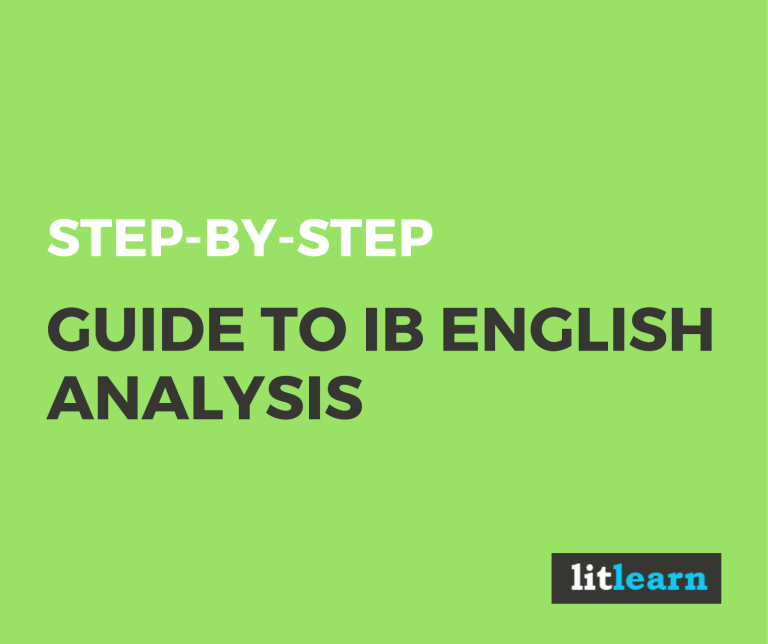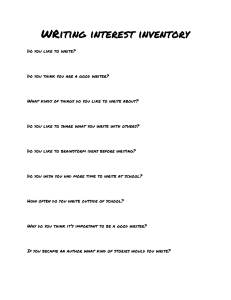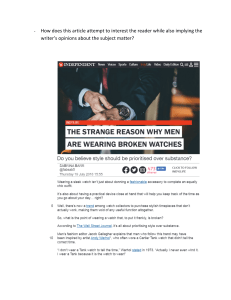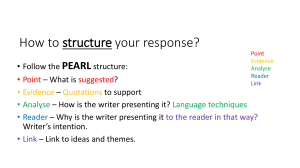
STEP-BY-STEP GUIDE TO IB ENGLISH ANALYSIS Hi there! You've just found the ultimate free guide to analysing IB English like a pro (well, sort of). I'm Jackson Huang. <handshake> I graduated from the IB with a perfect 45. Now I'm sharing my secrets to acing IB English--one of the toughest IB subjects to beat... Is this guide for me? Guide This guide is for IB English Literature and Language & Literature students who are sick of getting marked down. Do you struggle with: • Writing analysis? • Finding deep analysis? • Knowing what to write, and when? • Analysing techniques? If so, keep reading... Contents 1 What exactly is analysis? 2 Diagram of analysis 3 The Five Step formula 4 Summary Preface Guide To get a 7 in IB English, you must understand not just how to analyse, but how to analyse properly and correctly. It's so easy to be confused by all the contradictory advice that different IB English teachers and textbooks seem to be spouting out, but it's not as hard or as confusing as it seems. In this detailed guide, I explain the easiest, five-step approach to writing strong IB English analysis. I even explain intuition behind analysis and the five simple steps that you can take to transform your analysis from an IB grade of 4 to 7. No more headaches. No more confusion. So what are we waiting for? Let's get into it! What exactly is analysis? "Analysis is the act of explaining how and why a writer uses specific language choices." This is the fundamental task of IB English. If you truly understand this statement, then you will understand the whole of IB English. It's the key to the castle. So let's break down what it means. SPECIFIC LANGUAGE CHOICES whenever we analyse, we are intensely interested in the specific wording, literary techniques, punctuation, and grammar used by the writer of a given text. EXPLAINING always seek to explain these language choices rather than just stating the fact. Always go deeper. For example, don't just say "The writer uses technique X" and move on. You must go further in analysis by addressing two key questions: 1 How / in what way is technique X being used? 2 Why is technique X being used in this way? HOW 1. Is it being used to construct an idea or create an emotional effect, or both at the same time? 2. Is the technique being contrasted or combined with another technique to enhance its effectiveness? How a writer chooses to manipulate and utilise a technique is unique to every text. There are infinite ways in which a technique can be used, but your job is to just consider and explain a particular usage by a particular writer of a particular text. WHY Think about this... Why did the writer choose to use this specific word (or technique) instead of all the thousands of other capable options in the English language? Why this particular word? What makes this word/technique so special that the writer couldn't help but use it? Answering "why" is central to proper analysis. Diagram of analysis Guide Teachers never teach English with diagrams. But diagrams actually extremely useful in understanding how analysis works. This is what your understanding of analysis should look like right now. Forget what you learned about analysis before reading this guide. Everything that I'm teaching you now is the proven blueprint for IB English analysis. I used it to score 90% in IB English Literature, including a 20/20 in Paper 1. It works. Guide The next step in this guide is to you are here show you how to address these key questions of "how" and the "why" in your analytical writing. But first, let me introduce you to the Five Step formula, which I know you've been waiting for! next step The Five Step Formula of IB English Analysis So you have a quote that you want to analyse. An example might be: The wind danced to the music of the autumn birds as it wound its way through every branch, every tree, and every leaf in the quiet forest. Step 1. Identify specific language choices The first step of analysing any quote is a 3-part process. 1a Annotate the quote. 1b Find interesting language choices (i.e., literary techniques). 1c Decide on one or more techniques to analyse in your point. Steps 2 & 3. Explain "how" specific language is used So you've picked a specific technique from your imaginary quote. To address the "how" to a satisfactory standard, there are two things you must to do. 2 Explain how the specific technique creates a meaning (i.e. idea, theme, notion). Example The metaphor "the man was a mountain" constructs the notion of the man's strength. step 3 on next page Example 3 Explain how the chosen technique creates an effect on the reader. This is the component that probably 80% (!!!) of IB English students fail to include, and yes, it's one of the main things that drag down their mark. Don't fall for the trap of forgetting the effect. the language choice of "the man was a mountain" creates a feeling of fear in the reader, but that only occurs if "the man" refers to an evil character. If "the man" instead refers to a heroic figure, then the reader would feel an entirely different emotion, like awe or admiration. Quick summary: Steps 1, 2, and 3 Steps 4 & 5. Explain "why" specific language is used All writer's have a purpose. Perhaps they want to share a profound insight or an interesting story with the world. Or they might just want to entertain. In any case, writers write for a reason. That reason is to share some sort of message, idea or story through their words. If you don't get it, just imagine sitting down in front of an A4 piece of paper. Now tell yourself to write a novel. Without a reason to do so, you can't write half a page, let alone a short story! As you can see, every writer has a purpose, and his purpose influences his every word, technique and punctuation choice, down to the comma. So why is specific language used? The answer is simple: Because it helps the writer achieve his purpose. example of writer's purpose A certain JK Rowling is tossing up between using "horrendous" and "disturbing" to describe a scary Dementor in her upcoming Harry Potter book. Which word would she choose to use? Let's think it through in a logical way. Rowling's purpose would be to make the Dementor seem as horrifying as possible and to inspire as much fear from the reader as it is physically possible to do so. The word choice of "horrendous" holds much graver, darker connotations than the word "disturbing." A dead rat is disturbing; wearing socks with sandals is disturbing; but a Dementor is not disturbing, despite the irresistible alliteration that just rolls of the tongue: "disturbing Dementor". No, a Dementor is decidedly "horrendous", and that is why JK Rowling would have chosen "horrendous" over "disturbing" to describe her beloved Dementor. This specific language choice aligns best with her purpose. Steps 4 & 5 Concretely, Steps 4 and 5 of the LitLearn Five Step formula are these: 4 Explain how the meaning from Step 2 helps to achieve the writer's purpose. 5 Explain how the effect from Step 3 helps to achieve the writer's purpose. Full Five Step Diagram Here is the final diagram that summarises the Five Step formula of literary analysis for IB English. These are the basics of the Five Step formula. You've made a lot of progress making it this far, but there's still a lot to learn to get a 6 or 7... Summary In this free LitLearn guide, you've gained an understanding of exactly how IB English analysis works. A HUGE CONGRATS on learning the basics of the Five Step approach. It's helped countless of my students to score extremely high marks in their IB English exams and IAs. I'm confident it'll boost you up too! But wait! We've only done the basics! If you want to learn how to actually use the Five Step formula, enrol in our free, 3-day online course NOW.



